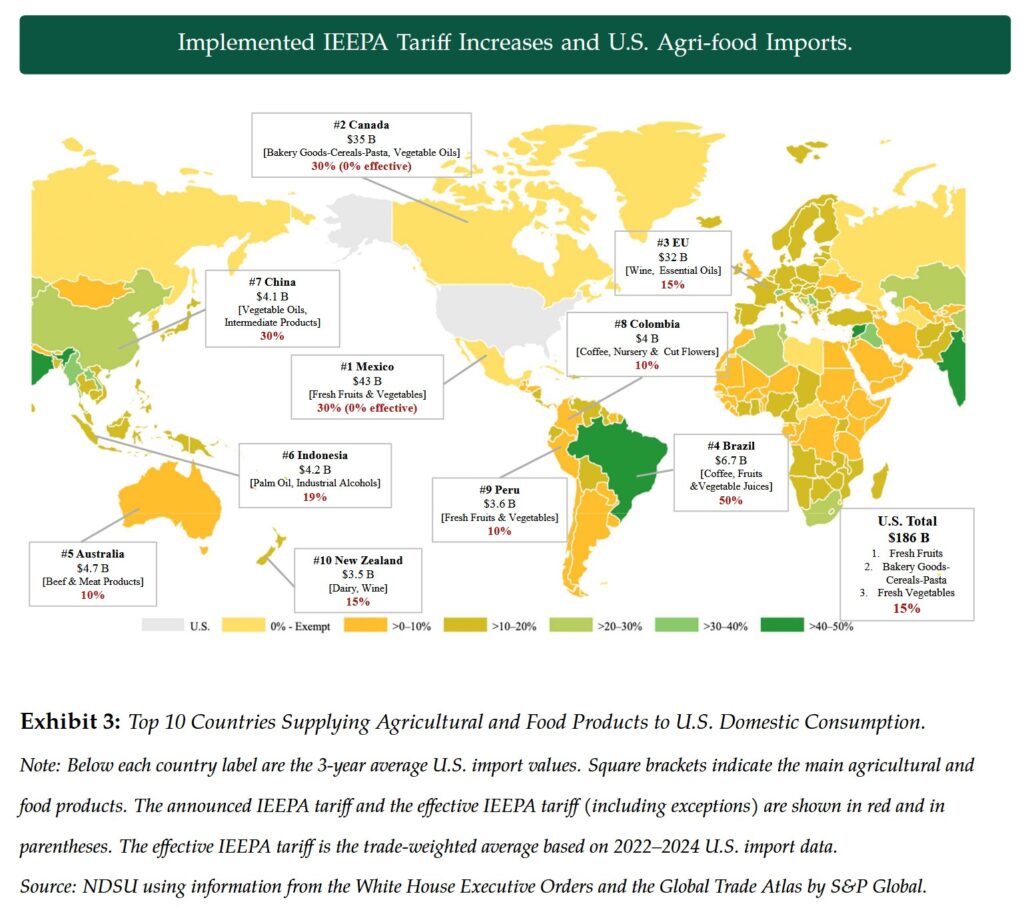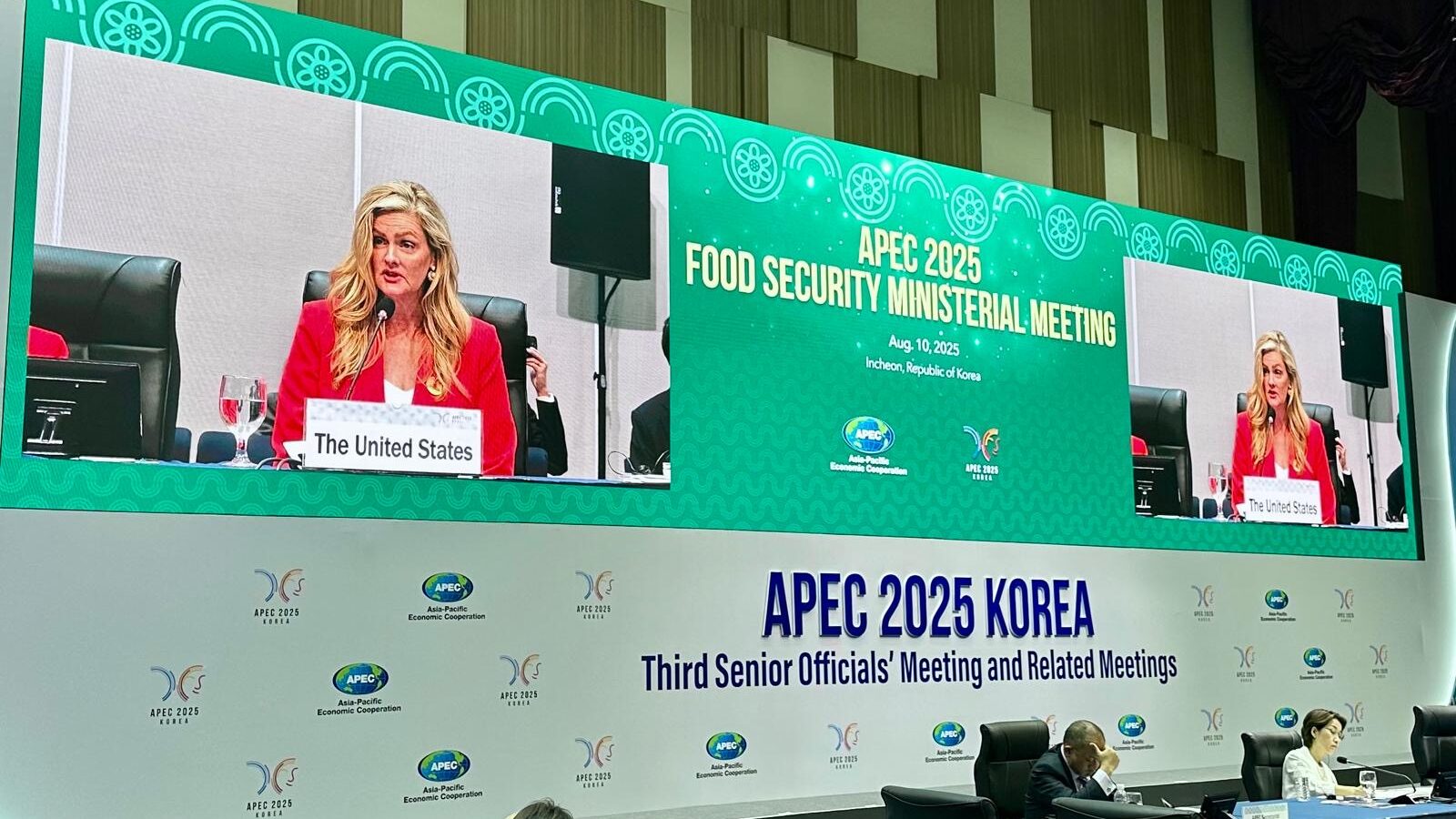TRADE UPDATE
Food & Agriculture
August 19, 2025
By Kristy Goodfellow, Vice President of Trade and Industry Affairs, and Ameya Khanapurkar, Project and Policy Coordinator
HIGHLIGHTS
- Tariffs and Bilateral Negotiations:
- The United States delayed implementing tariffs on imports from China for 90 days; the duties were scheduled to increase on Aug. 12 following high-level negotiations.
- Trade Remedies:
- China announced a 75.8% tariff on Canadian canola after a preliminary determination of the antidumping investigation on Canadian canola.
- Trade Data:
- North Dakota State University’s Center for Agriculture Policy and Trade Studies released the August 2025 issue of the Agriculture Trade Monitor, highlighting the surge in import duties, increasing cost of inputs, weak demand for U.S. commodities by China, and a mixed export picture.
- USDA:
- Newly confirmed USDA Trade and Foreign Agricultural Affairs Under Secretary Luke Lindberg emphasized his role in enforcing agricultural provisions in trade deals during the Midwest Agricultural Export Summit in Sioux Falls, South Dakota, where he was joined by other state and federal policymakers and business leaders.
- Multilateral:
- USDA participated in the 10th Asia-Pacific Economic Forum (APEC) Food Security Ministerial Meeting (FSMM) in Korea, where APEC partners asserted ongoing challenges in addressing food security; agreed to address challenges through innovation, digital technology, rural revitalization, and trade; and de-emphasized the role of the World Trade Organization.
- United Nations plastics treaty negotiations concluded on August 14 without agreement, and delegates remain divided over core issues such as production caps, chemicals of concern, and financing.
“There is no stagnation in trade. We are either losing ground or moving forward, and I am fighting hard and working with the Trump Administration to ensure American farmers and ranchers have a fair playing field in international markets and access to affordable and reliable inputs.”
—Rep. Adrian Smith (R-NE) X post commenting on the Midwest Agricultural Export Summit
Tariffs and Bilateral Negotiations
US AND CHINA DELAY ADDING MORE TARIFF
- The Trump Administration has again delayed implementing threatened tariffs that quickly escalated after Trump’s April 2“reciprocal tariff” announcement.
- U.S. reciprocal tariffs on China remain at 10%, which are in addition to the 20% fentanyl tariffs that were added earlier this year.
- The tariffs were originally set to be implemented on Aug. 12 and have been delayed to Nov. 10.
- The 90-day postponement followed high-level negotiations in Sweden and is intended to allow more time for negotiations.
- “China is worried about its shortage of soybeans. I hope China will quickly quadruple its soybean orders. This is also a way of substantially reducing China’s Trade Deficit with the USA,” President Donald Trump posted on social media before announcing the tariff extension. Soybean prices surged but dropped again because there does not appear to have been a purchase agreement.
Trade Remedies
CHINA HITS CANADIAN CANOLA
- China announced a 75.8% tariff on Canadian canola after a preliminary determination of the antidumping investigation on Canadian canola.
- This tariff is an ongoing development of tariff increases between the countries, which has affected Chinese electric vehicle and Canadian agricultural and fishery exports.
Trade Data
AUGUST 2025 NDSU AGRICULTURE TRADE MONITOR
- North Dakota State University’s Center for Agriculture Policy and Trade Studies released the August 2025 issue of the Agriculture Trade Monitor, highlighting the following:
- Import duties surge: the trade-weighted effective tariff on agri-food imports rose from 4% (MFN) to 15%. USMCA carve-outs and an EU arrangement cushion the aggregate impact, but non-exempt suppliers face 30–50% rates on items like coffee, bottled water, and packaged foods.
- Input costs rise: effective tariffs on farm inputs have increased from 1% to 12%, with pesticides up nearly 25% and tractors and parts 13–16% higher. Fertilizer price impacts remain muted due to Canadian exemptions.
- China demand weak: despite a 90-day tariff truce and an extended Section 301 exclusion window, U.S. exports to China are down about 53% year-to-date; forward sales for soybeans and beef remain subdued.
- Mixed export picture: June export value is up 3% year-over-year but down 2% year-to-date. Corn and ethanol are holding up; soybeans, beef, and poultry sit at five-year lows.


USDA
NEW USDA UNDER SECRETARY JOINS MIDWEST AGRICULTURAL EXPORT SUMMIT
- Newly confirmed USDA Trade and Foreign Agricultural Affairs Under Secretary Luke Lindberg participated in the Midwest Agricultural Export Summit in Sioux Falls, South Dakota, alongside Julie Callahan, assistant U.S. Trade Representative for agricultural affairs and commodity policy and the Trump Administration’s nominee for USTR chief ag negotiator, as well as many other state and federal policymakers and business leaders.
- Lindberg is reported to have emphasized his role in enforcing agriculture provisions in trade deals.
Today I spoke at the Midwest Agricultural Export Summit and connected with recently confirmed @USDA Under Secretary for Trade and Foreign Agricultural Affairs Luke Lindberg.
— Rep. Adrian Smith (@RepAdrianSmith) August 13, 2025
There is no stagnation in trade. We are either losing ground or moving forward, and I am fighting hard… pic.twitter.com/1F7rLp3UhN
Multilateral
ASIA-PACIFIC ECONOMIC COOPERATION (APEC)
- The 10th APEC Food Security Ministerial Meeting (FSMM) was held in the Republic of Korea on Aug. 10.
- The joint statement recognizes “the need for a constructive engagement on agriculture at the WTO.” This language contrasts the 9th APEC FSMM, which had much more expansive commitments to maintaining the WTO at the core of the trading system.
- Similar to previous joint declarations, this one recognizes ongoing challenges in addressing food security stemming from extreme weather patterns, demographic shifts, and supply chain disruptions.
- The declaration affirms members’ commitment to addressing food security through innovation, digital technology, rural revitalization, trade, and related ongoing APEC initiatives.
- USDA Trade and Foreign Agricultural Affairs Deputy Under Secretary Michelle Bekkering represented the United States.

UN PLASTICS TREATY NEGOTIATIONS
- The United Nations Environment Programme convened an Intergovernmental Negotiating Committee (INC) from Aug. 5-14 to continue negotiating an international, legally-binding instrument on plastic pollution, including measures addressing the marine environment.
- These negotiations, which started in 2022 under the Biden Administration, have been slow to progress. This round of negotiations concluded without agreement, and delegates remain divided over core issues such as production caps, chemicals of concern, and financing.
- Food and agriculture stakeholders have engaged in these negotiations to help shape the discussion around food packaging, produce stickers, and agricultural feedstocks for packaging and products.